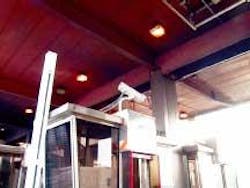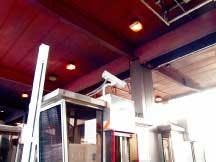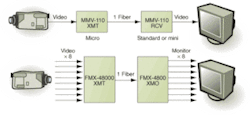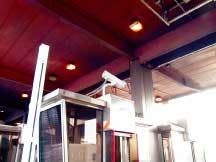Fiber adds networking qualities to vision
Increased bandwidth capacity, EMI resistance, long cable runs, and ruggedness promote optical systems in security, inspection, and process control.
By R. Winn Hardin,Contributing Editor
Advances in optical communications have led to less expensive and more pervasive optical-communication devices, including easier-to-use fiber cable and connectors, laser sources, transmitters and receivers. Although relatively new to machine vision, optical communication offers several important benefits compared to copper transmission. Optical communication, or the practice of encoding data into light pulses transmitted through glass or plastic fiber, is a resilient digital-transmission scheme that can carry data across considerably longer distances than copper. Glass fibers do not have a galvanic response to water, salt, and liquids like metal wires, making them strong contenders for hazardous or unique environments. In addition, optical fiber is immune to interference by external electromagnetic sources and can carry considerably more data (bandwidth) than common copper-transmission methods.
Machine-vision transmission standards have evolved from copper-based transmission standards, such as RS-232 with 20-kbits/s transmission across 50 ft of wire (at maximum baud rate), to RS-422 and RS-485, which offer 100-kbit/s to 10-Mbit/s transmission across distances up to 4000 ft, to the widely used Channel Link/RS-644 standard, capable of sending 400 Mbits/s across 30 m of copper.
How much is enough?
As machine-vision systems transitioned from single-node inspection-and-control systems to distributed networks for process and manufacturing control, communications protocols that eased network design and integration became a priority. This led the vision industry to adopt Ethernet over copper with transmission between 10 and 100 Mbits/s to Gigabit Ethernet (GigE) with up to 1000-Gbits/s transmission capabilities and to the competing FireWire (1394a and b) standards, which can send between 100 and 1200 Mbits/s across distances of 4.5 m on copper to 500 m on multimode optical fiber. Finally, the predominant transmission types also include ANSI’s Fibre Channel transmission protocol, developed for large data-storage applications. Fibre Channel provides transmission rates between 133 Mbits/s to 1 Gbit/s across distances up to 10 km on single-mode fiber (considerably less on multimode glass or plastic optical fiber).
Plastic fiber is lossey compared to glass fiber and is typically used on runs of 100 ft or less, while multimode glass fiber works well in the hundreds of meters, and single-mode fiber operates up to several kilometers at considerably higher cost per linear foot. The upshot is that more than 90% of machine-vision systems that use fiber use standard telecom 50- or 62-μm cores with 125-μm cladding multimode fiber with standard SC connectors. Copper can run as far as plastic, and single-mode is overkill for most applications. Therefore, multimode fiber is the winner for machine vision.
Vic Wintriss, president of Wintriss Engineering, points out that the machine-vision industry has typically put bandwidth growth before transmission distance when selecting cabling and protocols. But, he cautions, bandwidth isn’t the end-all/be-all for machine-vision applications.
“We use Fibre Channel [over fiber] in addition to copper with our cameras, but we don’t typically need to run it over optical fiber. Everybody’s pushing for higher bandwidths in the vision industry, and that can be a mistake. I think the answer is smart cameras that do the processing at the front end and transmit results instead of sending massive amounts of unprocessed data,” Wintriss explains. “Fiber communi cation is nice because there’s no noise, you can run long distance, and it’s clean, but the industry is primarily exploiting it because of high bandwidth.”
For example, Wintriss recently installed OPSIS 5150 HL digital linescan cameras with Fibre Channel output at several tollbooths on the New Jersey Turnpike (see photo on p. 21). Connected by multimode fiber to a standard Fibre Channel PCI board in a remote PC host, the OPSIS 5150 HL with an on-camera FPGA uses image-analysis software to identify toll violators, locate their license plate, and pass that information along to a PC host for storage and later action. “We used fiber for the distances between cameras and host, but also because of lightning. Long copper runs can act like an antenna, and one lightning strike can scramble the system.” Wintriss added that without the lighting concern, the company may have selected Fibre Channel over copper because it can run up to 300 m.
Accumulated Bandwidth
Traffic monitoring and security-and- surveillance applications are among the biggest drivers for the use of optical fiber with machine vision. In many cases, both distance and bandwidth are primary concerns because human operators often monitor these systems, and they need to see the full frame for reference, even when image processing generates automated alarms, as in the case of tollbooth violators and security systems, instead of the traditional pass/fail result from a vision processor in industrial applications.
Traffic monitoring-identifying cars that run red lights or tollbooths or violate secure zones-is evolving, too. According to Logical Solutions director of engineering Kevin Keefe, traffic-monitoring-system designers are moving the camera further away from the area under observation so that a single camera can view a larger area; high-resolution, megapixel-or-more sensors help to guarantee that the camera can capture a clear picture of a smaller region of interest, such as a car’s license plate, while still monitoring a large area. “You raise the camera up high to get the wide area, and then [electronically] zoom in as necessary. To do that you need high bandwidth and more distance between sensor and processor, which leads to fiber communications,” Keefe says.
The Tattile USA TAG family of GigE cameras-designed to run over Cat5E copper cable-may help to transition the emerging trend of optical fiber communications in traffic and security vision systems to more traditional industrial inspection and process-monitoring applications. “GigE over Cat5E is useful because you get extended transmission distance and very high bandwidth for a small amount of money,” explains Tattile USA president John Merva. “Cat5E cables are limited to less than the 100 m spec in industrial environments. Fibre Channel will allow extended transmission distance in applications where distance is important, such as security and process monitoring in steel and paper mills.”
To help reduce the amount of data that needs to be sent over the network, Tattile has added in-camera image processing to the TAG and new XPTAG camera lines. Tattile announced its new XPTAG camera in October at Vision 2004 in Stuttgart, Germany. This camera not only transmits at GigE speeds, but runs the Windows XP operating system inside the camera to allow full image-processing routines to be run at the camera, reducing network data considerably.
Because of the dearth of optical-fiber-ready cameras and to accommodate a wider variety of cameras with varying copper-standard outputs, companies such as Arvoo, Logical Solutions, and Opticomm have developed fiber bridges that accept a variety of standard protocols and output to an optical fiber. Opticomm offers several multiplexing variations with separate channels for video, data, and audio and/or accommodating multiple video sources across the same fiber (see Fig. 1). In essence, these fiber bridges extend the transmission capability of shorter copper-based transmission schemes from several meters up to 500 m on average, with single-mode fiber variants available for traffic monitoring and large-factory applications with kilometer runs between imaging sensors, processors, and storage.
In steel mills, where process monitoring can require several cameras spread around a several-hundred-meter area, optical fiber offers strong resistance to electromagnetic interference (EMI) generated by furnaces and electrical motors compared to copper transmission schemes-even if the reach of the copper transmission scheme allows for the long cable runs.
Prosilica is one manufacturer that is producing a direct-to-fiber output camera for these types of applications through its CV1280F and CV640F BW models and color camera variants. “Most customers look at fiber because of the distance it can carry a signal, but we’ve seen some applications where EMI is also important, such as the monitoring of automobile dashboards during EMI testing,” explains Marty Furse, Prosilica CEO.
A battery-powered camera is placed in an environmental enclosure and fiber runs from the chamber to the control room where the signal is collected by a Prosilica PC1394B fiber PCI card. Because the signal is already digital, the card acts mainly as an I/O interface rather than a frame grabber with on-board processing. Prosilica also offers adapter boxes with 1394a copper input and 1394b optical-fiber output for installations where the processing is done on a laptop and PCI buses are not available.
Robot Guidance
Prosilica has used a similar image-acquisition and processing design for robot guidance (see Fig. 2). “Using fiber with machine vision for robot guidance does not have much to do with the length of the cable, but it does with the flex of the cable,” Furse says. “Copper wire will only flex for so long before it starts to break down, but glass fiber, with an even tighter bending radius than copper, doesn’t have that problem. Fiber is more delicate, but it is like fishing line. Fishing line is delicate, but you can bend it forever. Do the same with copper wire and it will eventually break.”
Opticomm has had similar experiences with LCD manufacturing operations and use 16 to 20 cameras per LCD glass-panel manufacturing machine that resemble web-inspection and printing applications (seeVision Systems Design, Aug. 2004, p. 43). Mounted on robotic arms, coaxial cable has been the traditional method to connect the cameras to a nearby control room. However, as the LCD panel industry continues to see massive expansion and investment, there’s a need to add additional machines and centralize the control room. “They want to convert to fiber because of the flexibility that fiber gives them. It’s lightweight, which is good for robot movement, has a good bending radius compared to copper, and won’t wear and tear like copper. And with fiber, they can move the control room further away and accommodate more machines in the same plant,” says Alon Kadar, Opticomm vice president of business development.
Optical fiber allows the same networking capabilities as common copper protocols but across longer distances and with greater reliability than copper. It’s not likely that the pragmatic machine-vision industry will follow the same bandwidth craze of the telecom industry, but bandwidth combined with EMI resistance, long cable runs, ruggedness, and other qualities are likely to carve an increasing niche for this technology in automated inspection systems in security, inspection, and process control.Company Info
Arvoo Imaging Products, Woerden, The Netherlandswww.arvoo.com
Logical Solutions, Milford, CT, USAwww.think-logical.com
Opticomm, San Diego, CA, USAwww.opticomm.com
Prosilica, Burnaby, BC, Canadawww.prosilica.com
Tattile USA, Bedford, NH, USAwww.tattileusa.com
Wintriss Engineering, San Diego, CA, USAwww.wintriss.com



